Servicios Personalizados
Revista
Articulo
Indicadores
-
 Citado por SciELO
Citado por SciELO
Links relacionados
-
 Similares en
SciELO
Similares en
SciELO
Compartir
Latin American applied research
versión impresa ISSN 0327-0793
Lat. Am. appl. res. vol.41 no.3 Bahía Blanca jul. 2011
Radiative heat transfer to blood flow through a stenotic artery in the presence of magnetic field
J. Prakash† and O.D. Makinde‡
† Department of Mathematics, Faculty of Science, University of Botswana, P/Bag 0022, Gte, Botswana.
prakashj@mopipi.ub.bw
‡ Faculty of Engineering, Cape Peninsula University of Technology, P. O. Box 1906, Bellville 7535, South Africa
makinded@cput.ac.za
Abstract - In this paper, we examine the effect of thermal radiation on the blood flow through a stenosed artery under the combined actions of axial pressure gradient and applied magnetic field. The blood flowing through the artery is considered to be Newtonian and its viscosity radial co-ordinate dependent due to hematocrit variation. Analytical expressions are obtained for the flow velocity, temperature, the volumetric flow rate, wall shear stress and wall heat transfer rate. Discussions are made from a physiological point of view. The effects of various embedded parameters are discussed with the help of graphs. Thus, the study can be used for clinical purposes, especially in the area of deep heat therapy.
Keywords - Magnetic effect, Radioactive heat, Blood flow, Arterial stenosis.
I. INTRODUCTION
The death rate, in the developed world, from heart attack and other diseases related to the obstruction of blood flow is quite high which perhaps explains why a lot of work on blood flow has been reported in the literature by Rao and Deshikachar (1988), and Ogulu and Bestman (1993a,b). A narrowing that causes an obstruction to blood flow is called stenosis. A complete obstruction to blood flow (no flow) is called atresia. The Pulmonary valve allows blood to flow from the right ventricle to the lungs. Stenosis can occur at the level of the valve or directly below it (sub pulmonary Stenosis). While the exact mechanism of the formation of stenosis in a conclusive manner remains somewhat unclear from the standpoint of pathology/physiology, deposition of various substances like cholesterol on the endothelium of the arterial wall and proliferation of the connective tissues are believed to be the factors that accelerate the growth of the disease. Early investigators (Lih, 1969; Halder, 1987; Prakash and Ogulu, 2007) have studied the flow characteristics of blood in artery with mild stenosis by considering blood as Newtonian and Non-Newtonian fluids. Chow and Soda (1972) looked at laminar flow in tubes with construction to understand the abnormal flow conditions caused by the presence of stenosis in arteries.
Moreover, the red blood cell (RBC) is a major biomagnetic substance, and the blood flow may be influenced by the magnetic field. The magnetic properties of RBCs play important roles in the increase in blood viscosity during exposure to a static magnetic field. As oxygenated hemoglobin is diamagnetic and deoxygenated hemoglobin is paramagnetic as per Pauling and Coryell (1936), the magnetic susceptibility of hemoglobin in RBCs varies greatly from negative in arteries to positive in veins as reported (Shalygin et al., 1983; Weisskoff and Kiihne, 1992; Sakhnini and Khuzaie, 2001). Therefore, in an external magnetic field, the magnetic moment on the RBC varies due to blood oxygenation. Sud and Sekhon (1989)studied the blood flow through the human arterial system in presence of a magnetic field. Magnetic stress is caused by physical interactions between the magnetic field and biological substances, one of which is the magnetic torque on the magnetic moment induced by bio-magnetic substances (Higashi et al., 1993). Haldar and Ghosh (1994)investigated the effect of an externally applied uniform magnetic field on the blood flow in a single constricted blood vessel. The role of magnetic field in arterial blood flow has been reviewed by many authors (Chen, 1985; Prakash et al., 2004; Mustapha et al., 2009; Tzirtzilakis, 2005, 2008; Bali and Awasthi, 2007; Mekheimer and El Kot, 2008).
Furthermore, study related to thermal radiation effect on the physiological flow system is extremely useful and of biomedical interest, Falk and Issels (2001). In pathological situation, thermal radiation therapy is one of the treatments employed by medical practitioners, Ogulu and Bestman (1993a, b). The procedure involves transmitting heat below the skin surface into tissues and muscles. Deep heat speeds up healing by increasing blood flow to the injury. Electromagnetic heat, such as short waves and micro waves, sends heat up to 2 inches into the tissue and muscles. It works best for injuries in joints, muscles, and tendons. Heat therapy may help reduce pain. For cancer treatment, thermal radiation therapy is also employed (Zee, 2002; Tashtoush and Magableh, 2008; Kenjeres and Opdam, 2008).
Motivated by the above studies, our aim is to investigate the effect of radioactive heat absorption on the magnetic field resistance to blood flow through stenotic artery. In Section II the mathematical formulation of the problem is established. The solutions to the problem are obtained in Section III. Quantitative discussions of the solutions are given in Section IV.
II. MATHEMATICAL MODEL
Let us consider steady laminar fully developed one-dimensional flow of blood through a stenosed artery.
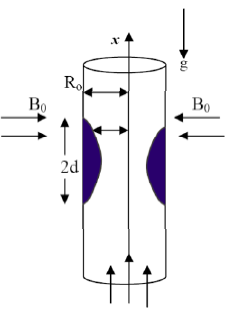
Figure 1: Geometry of stenosis
For the development of mathematical model, the following assumptions are made:
(i) The flow is incompressible so that the simple equation of state for a Boussinesq fluid holds in gravitational field acting in reverse direction to x. (ii) Viscosity of blood varies radially with maximum magnitude along the arterial centre line due to the accumulation of RBC in this region. (iii) The temperature difference of the blood and artery is high enough for radiative heat transfer to be valid. (iv)The stenosis is mild and develops symmetrically about the axis of the tube. (v) Magnetic field applied externally in the perpendicular direction to the flow field is of constant strength. (vi) The electromagnetic force produced is very small. (vii) Electrical conductivity is small.
Under the above mentioned assumptions, the one dimensional equations of motion and energy balance for the steady and axially symmetric flow of blood through an artery provided with a mild stenosis are given by
 | (1) |
 | (2) |
 | (3) |
 | (4) |
where u is the blood axial velocity, T is the blood temperature, Tw is the arterial wall temperature, T0 is the blood reference temperature, g is the gravitational acceleration,ρ is the density, β is the thermal expansion coefficient, B0 is the intensity of magnetization, σ;e is the electric conductivity of the blood, k is the blood thermal conductivity and  is the blood pressure. Let us consider a bell-shaped stenosis geometry given by
is the blood pressure. Let us consider a bell-shaped stenosis geometry given by
 | (5) |
where  is the radius of the blood vessel in the stenotic region, R0 is the radius of the normal blood vessel, δ is the depth of the stenosis at the throat and λ is a parametric constant; ε characterizes the relative length of the constriction. The most general differential approximation for the radiative flux qr as given by Cheng (1964) is
is the radius of the blood vessel in the stenotic region, R0 is the radius of the normal blood vessel, δ is the depth of the stenosis at the throat and λ is a parametric constant; ε characterizes the relative length of the constriction. The most general differential approximation for the radiative flux qr as given by Cheng (1964) is
 | (6) |
where α is the absorption coefficient and σ; is the Stefan-Boltzman constant. For the optically thin case that we adopt in the present study, α<<1 and an approximate form of the radiative flux equation could be taken as
 | (7) |
Following Lih (1969), the transverse variation in the blood viscosity μ(r) is taken as
 | (8) |
where c = 2.5 (a constant), and h(r) is the hematocrit function given as
 | (9) |
where hm is the maximum hematocrit at the centre of the blood vessel and n ( ≥ 2) is a parameter determining the exact shape of the profile. Equation (9) is valid only for dilute suspension of red cells which are assumed spherical as in Lih (1969), Sakhnini and Khuzaie (2001).
Introducing the following dimensionless quantities;
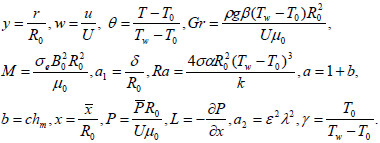 | (10) |
In view of the above non-dimensional variables, Eqns. (1)-(9) are reduced to non-dimensional form as
 | (11) |
 | (12) |
 | (13) |
 | (14) |
where Ra is the radiation absorption parameter, Gr is the Grashof number, γ is the temperature difference parameter, L is the constant axial pressure gradient parameter and M is the magnetic field parameter. The volumetric flow Q of fluid in stenotic region given by
 | (15) |
The shear stress and the rate of heat transfer at the wall are given by
 | (16) |
III. SOLUTION METHOD
To tackle the problem as posed in Eqns. (10) - (14), it is convenient to form a power series expansion in the radiation parameter N for the temperature field, i.e.
 | (17) |
The solution for the velocity field is taken as suggested by Ogulu and Bestman (1993a, b) and Prakash et al. (2004)
 | (18) |
where
 | (19) |
 | (20) |
Substituting the solution series from Eqns. (17)-(20) into Eqns. (11)-(14) and collecting the coefficients of like powers of N, M and b, we obtained and solved the equations for the coefficients of solution series iteratively. With a computer symbolic algebra package (MAPLE, http:// maplesoft.com/ products/ maple. technical. Aspx) the first few terms of the above solution series are obtained. Some solutions for the temperature and velocity fields are given in the appendix.
IV. NUMERICAL COMPUTATION AND DISCUSSION OF RESULTS
The analytical expressions derived in the preceding section have been numerically computed, when n = 3, L=1, a1= 0.5, a2 = 0.2, γ = 0.1, a = 1.2, b = 0.2, Gr = 0.5, for different values of magnetic parameter (M) and radiation absorption parameter (Ra). In Figs. 2 - 3 we depict the variation of velocity (w) with radial axis (y) for different value of radiation absorption parameter and magnetic field parameter. As the thermal radiation absorption increases, the blood velocity increases. In a pathological situation, deep heat speeds up healing by increasing blood flow to the injury. However, it is observed that the application of a uniform magnetic field has a decreasing effect on the velocity of blood flow. This agrees with earlier results as reported by Chen (1985), Rao and Deshikachar (1988), Haldar and Ghosh (1994), Prakash and Makinde (2004).
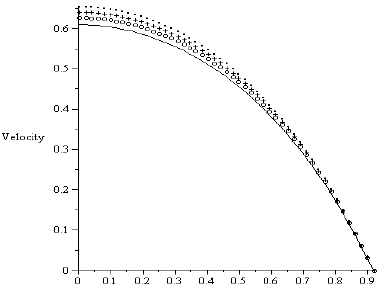
Figure 2 Effect of thermal radiation on velocity profile: x=3; M = 0.5; _____Ra = 0; ooooo Ra = 0.1; ++++ Ra = 0.3; …Ra = 0.5
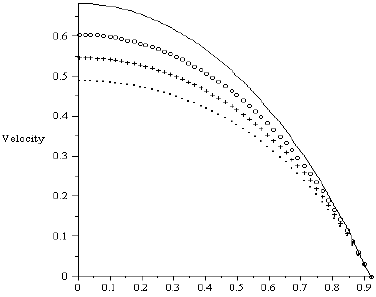
Figure 3 Effect of magnetic field on velocity profile: x = 3; Ra = 0.5; _____M = 0; ooooo M = 0.1; ++++ M = 0.3; ……M = 0.5
The temperature profile is illustrated in Fig. 4, the blood temperature is maximum along the arterial centre line and minimum at the wall. It may be noted that the blood temperature increases with an increase in thermal radiation absorption. In pathological situations, thermal therapy is usually used in order to expose body tissue and cancerous tumor to high temperature. The increase in blood temperature due to thermal radiation absorption will make cancer cells more sensitive to radiation, hence damage and kill cancer cells associated with tumors with minimal injury to normal tissues.
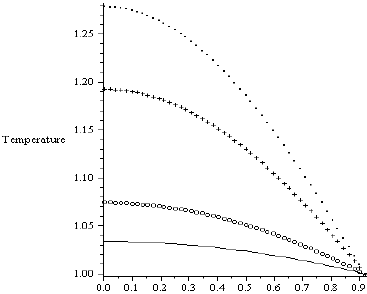
Figure 4 Effect of thermal radiation absorption on temperature profile: x = 3; ____Ra = 0.1; ooooo Ra = 0.2; ++++ Ra = 0.4; ……Ra = 0.5
Figures 5 - 6 depicts the variation of the skin-friction with the height of the stenosis when the blockage of the vessel is 50% (i.e. a1 = 0.5). It is observed that the skin-friction increases with the height of the stenosis. One may further note that the rate of increase in skin-friction is enhanced with increasing thermal radiation absorption

Figure 5 Effect of thermal radiation absorption on wall shear stress: M=0.5;_____Ra = 0; ooooo Ra = 0.1; ++++ Ra = 0.3; ……Ra= 0.5
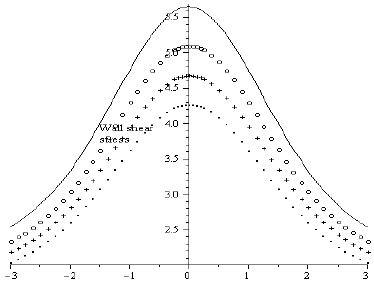
Figure 6 Effect of magnetic field on wall shear stress: Ra = 0.5; _____M = 0; ooooo M = 0.1; ++++ M = 0.3; ……M = 0.5
and the rate decreases when magnetic field parameter assumes greater values.
Figure 7 depicts the variation of the rate of heat transfer at the wall with the height of the stenosis. It is observed that arterial wall heat transfer rate increases with increase in the stenosis height. Further increase is observed with an increase in radiation absorption.
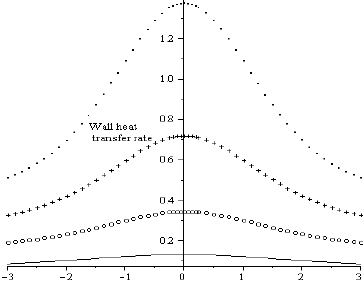
Figure 7 Effect of thermal radiation absorption on wall heat transfer rate: _____Ra = 0.1; ooooo Ra = 0.2; ++++ Ra = 0.3; ……Ra = 0.5
Thus the computational results for the velocity, temperature, skin-friction and the rate of heat transfer at the wall obtained from the present study are displayed in Figs. 2 - 7 shown above.
V. CONCLUSIONS
The effects of the thermal radiation absorption and the magnetic field on the stenosis geometry have been observed throughout and the results obtained are of physiological interest and clinical applications. The study reveals that, for patients undergoing thermal radiation therapy, the resistance to blood flow due to magnetic field and stenosis is reduced by increasing thermal radiation absorption.
APPENDIX
Some computed results for the temperature and velocity fields.

REFERENCES
1. Bali, R and U. Awasthi, "Effect of a magnetic field on the resistance to blood flow through stenotic artery," Applied Mathematics and Computation, 188, 1635-1641 (2007). [ Links ]
2. Chen, I.H., "Analysis of an intensive magnetic field on blood flow: part 2," J. Bioelectr.,4, 55-61 (1985). [ Links ]
3. Cheng, P., "Two dimensional radiating gas flow by a moment method,"A I A A J., 2, 1662-1664 (1964). [ Links ]
4. Chow, J.C. and K. Soda, "Laminar flow in tubes with constriction," Phys. Fluids, 15, 1700-1706 (1972). [ Links ]
5. Falk, M.H. and R.D. Issels, "Hyperthermia in Oncology," International Journal of Hyperthermia,17, 1-18 (2001). [ Links ]
6. Haldar, K., "Oscillatory flow of blood in a stenosed artery," Bulletin of Mathematical Biology, 49, 279-287 (1987). [ Links ]
7. Haldar, K. and S.N. Ghosh, "Effect of a magnetic field on blood flow through an indented tube in the presence of erythrocytes," Indian J. Pure Appl. Math., 25, 345-352 (1994). [ Links ]
8. Higashi, T., A. Yamagishi, T. Takeuchi, N. Kawaguchi, S. Sagawa, S. Onishi and M. Date, "Orientation of erythrocytes in a strong static magnetic field," Blood, 82, 1328-1334 (1993). [ Links ]
9. Kenjeres, S. and R. Opdam, "Computer simulations of a blood flow behavior in simplified stenotic artery subjected to strong non-uniform magnetic fields," IFMBE Proceedings, 22, 2604-2608 (2008). [ Links ]
10. Lih, M.M, Transport Phenomenon in Medicine and Biology, John Wiley and Sons Inc. (1969). [ Links ]
11. Mekheimer, Kh.S. and M.A. El Kot, "Influence of magnetic field and Hall currents on blood flow through a stenotic artery," Appl. Math. Mech. -Engl. Ed., 29, 1093-1104 (2008). [ Links ]
12. Mustapha, N., N. Amin, S. Chakravarty and P.K. Mandal, "Unsteady magnetohydrodynamic blood flow through irregular multi-stenosed arteries," Computers in Biology and Medicine, 39, 896-906 (2009). [ Links ]
13. Ogulu, A. and A.R. Bestman, "Deep heat muscle treatment: A mathematical model 1," Acta Physica Hungarica, 73, 3-16 (1993). [ Links ]
14. Ogulu, A. and A.R. Bestman, "Deep heat muscle treatment: A mathematical model II," Acta Physica Hungarica, 73, 17-27 (1993). [ Links ]
15. Pauling, L. and C.D. Coryell, "The magnetic properties and structure of hemoglobin, oxyhemoglobin and carbonmonoxyhemoglobin," Proc. Natl. Acad. Sci. USA,22, 210-216 (1936). [ Links ]
16. Prakash, J., O.D. Makinde and A. Ogulu, "Magnetic effect on oscillatory blood flow in a constricted tube," Botswana Journal of Technology, 13, 45-50. (2004). [ Links ]
17. Prakash, J. and A. Ogulu, "A study of pulsatile flow modeled as a power law fluid in a constricted tube," International Communications in Heat and Mass Transfer, 34, 762-768 (2007). [ Links ]
18. Rao, A.R. and K.S. Deshikachar, "Physiological type flow in a circular pipe in the presence of a transverse magnetic field," J. Indian Inst. Sci., 68, 247-260 (1988). [ Links ]
19. Sakhnini, L. and R. Khuzaie, "Magnetic behavior of human erythrocytes at different hemoglobin states," Eur. Biophys. J., 30, 467- 470 (2001). [ Links ]
20. Shalygin, A.N., S.B. Norina and E.I. Kondorsky, "Behavior of erythrocytes in high gradient magnetic field," J. Magn. Mater.31, 555-556 (1983). [ Links ]
21. Sud, V.K. and G.S. Sekhon, "Blood flow through the human arterial system in the presence of a steady magnetic field," Physiol. Med. Biol.34, 795-805 (1989). [ Links ]
22. Tashtoush, B. and Z. A. Magableh, "Magnetic field effect on heat transfer and fluid flow characteristics of blood flow in multi-stenosis arteries," Heat Mass Transfer, 44, 297-304 (2008). [ Links ]
23. Tzirtzilakis, E.E. "A mathematical model for blood flow in magnetic field," Physics of Fluids, 17, 77-103 (2005). [ Links ]
24. Tzirtzilakis, E.E., "Biomagnetic fluid flow in a channel with stenosis," Physica D, 237, 66-81 (2008). [ Links ]
25. Weisskoff, R.M. and S. Kiihne, "MRI susceptometry: image-based measurement of absolute susceptibility of MR contrasts agents and human blood," Magn. Reson. Med.,24, 375-383 (1992). [ Links ]
26. Zee, J. van der., "Heating the Patient: A Promising Approach," Annals of Oncology,13, 1173-1184 (2002). [ Links ]
Received: June 5, 2010
Accepted: November 11, 2010
Recommended by Subject Editor: Walter Ambrosini














